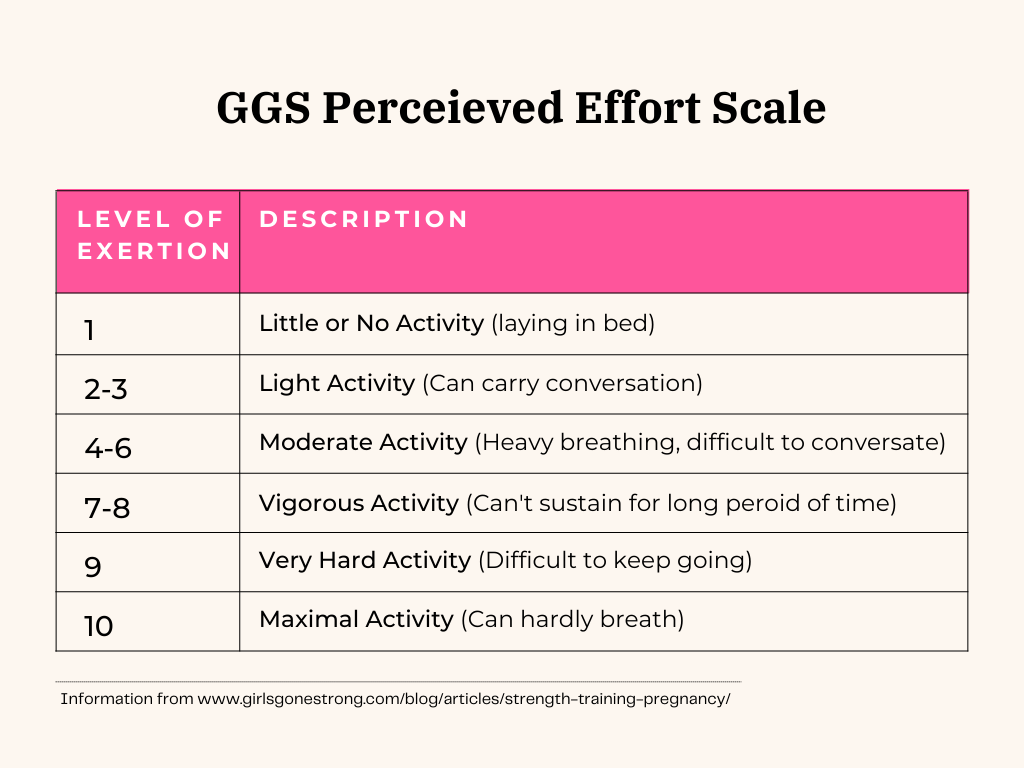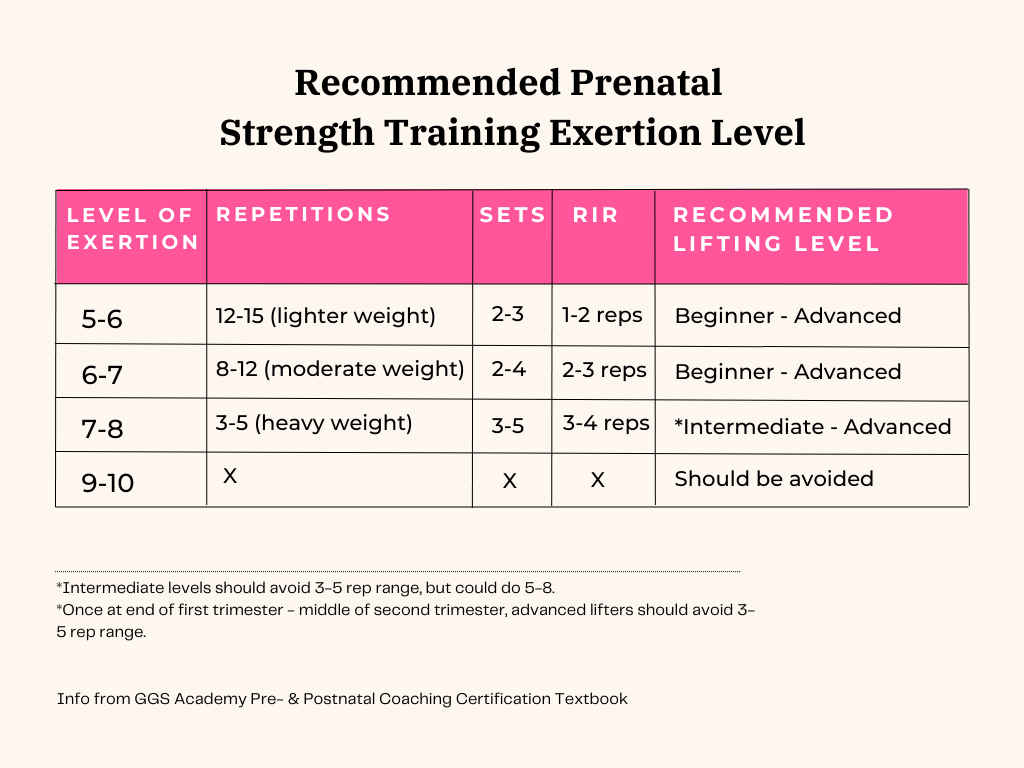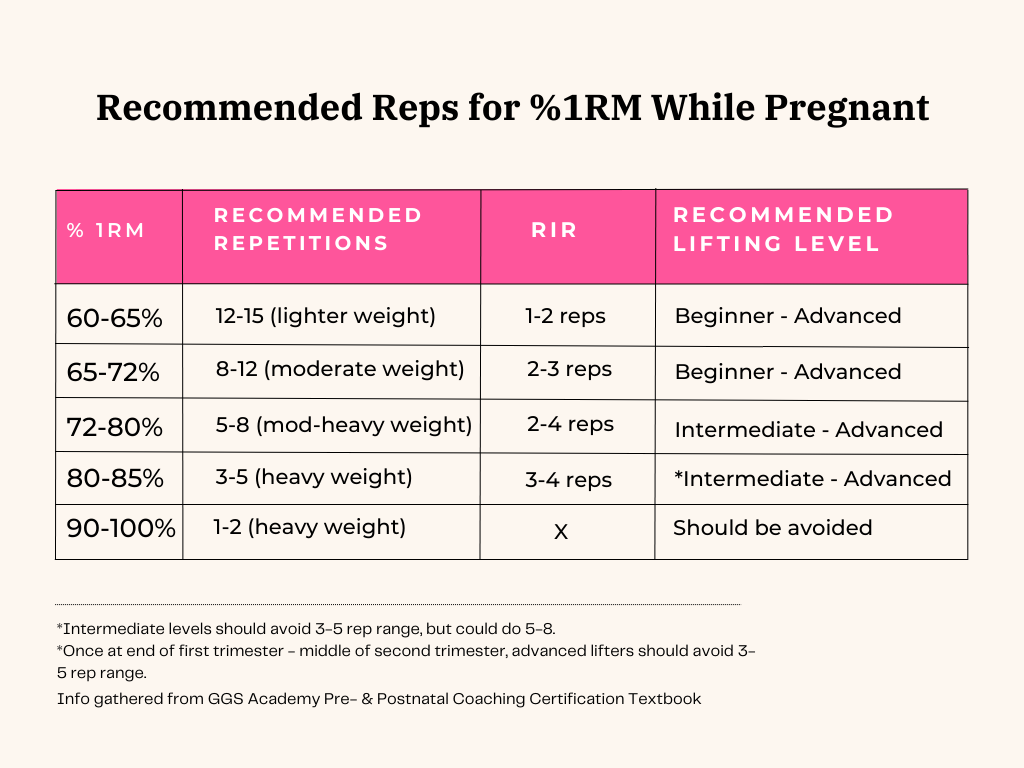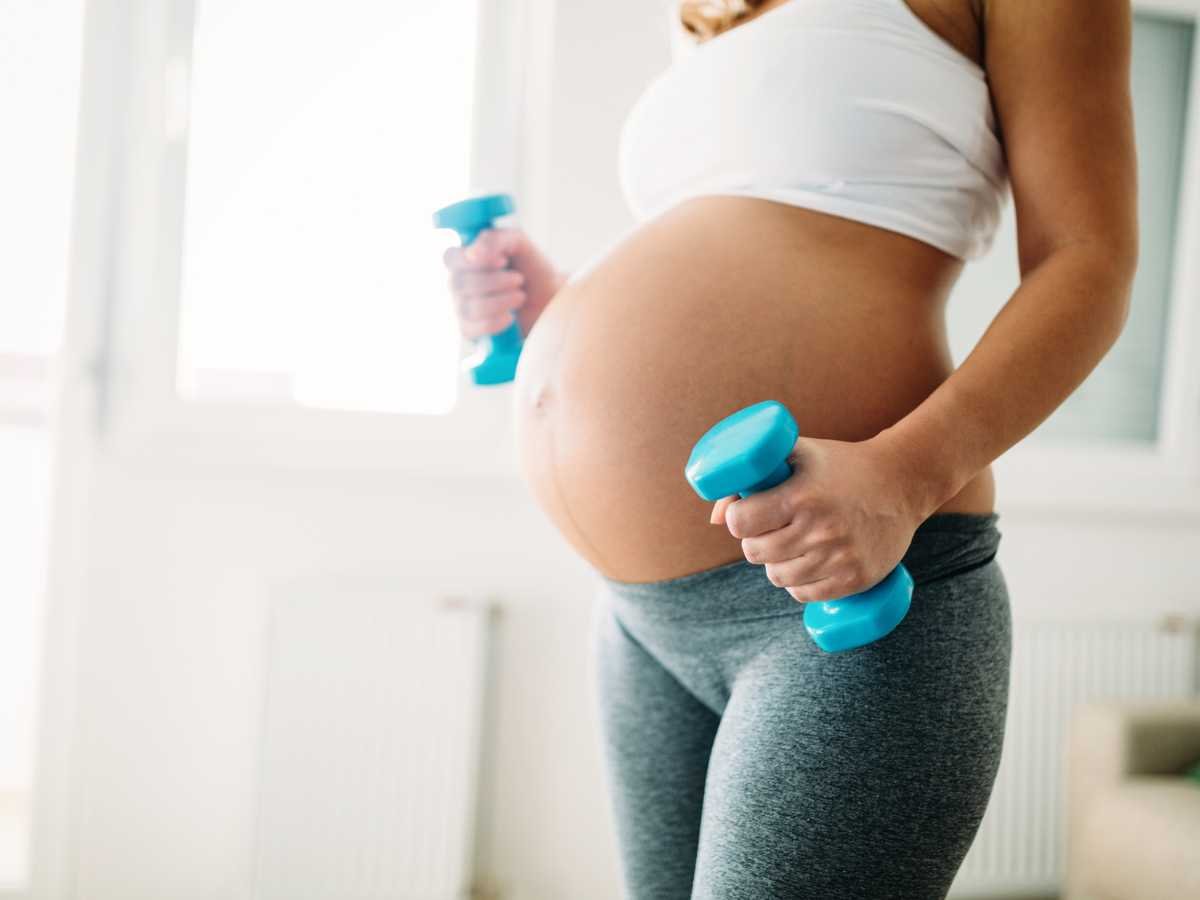A Complete Guide to Safe and Effective Exercise During Pregnancy
A Guide to Start or Continue Exercise During Pregnancy
You just found out you’re pregnant. Congratulations, mama! Now you are wondering if it is safe for you to start exercising. There’s lots of information on what not to do while pregnant, but not enough that takes you step by step on all the components of a prenatal exercise program. With safety and effectiveness in mind, this guide will help you start or continue exercise during your pregnancy.
The bottom line is exercise is important throughout your entire pregnancy! We are going to discuss these benefits, and recommendations for strength training, and exercise frequency and intensity. If you are eager to have a healthy and happy pregnancy, then let’s get started!
*Disclaimer – If you are a postpartum, pregnant or have any other health conditions, make sure you always seek the advice of your physician or other qualified health care provider. Content on this blog should not be considered a substitute for professional medical advice, expertise, or treatment.
Benefits of Exercise During Pregnancy
You are probably wondering if it’s even worth it to exercise with pregnancy being hard enough as it is.
The answer is yes!
Exercising in your first trimester and throughout offers many benefits to you and baby. One of the first benefits you will notice is an increase in energy and mood. This can be very beneficial in the beginning weeks of pregnancy when fatigue is at an all-time high. Exercise will also help relieve constipation, improve sleep, promote healthy weight gain, and will help you build or maintain strength and muscle mass.
As your body grows with baby, you may start to have increased aches and pains. Strengthening the muscles of your core and posterior chain will improve your posture and alignment which will help reduce pain in the low back, pelvis, and upper back that comes with growing belly and breasts.
Exercise has also been shown to reduce the risk of gestational diabetes, preterm labor, gestational hypertension, and needing a cesarean birth [5].
Keep in mind these benefits also carry over into postpartum. Exercising throughout pregnancy will help prepare your body for the hard work of labor and delivery and may result in a better recovery. Staying active throughout pregnancy will also make for an easier transition back to a healthy weight postpartum.
During pregnancy you have quite a lot of strain on your pelvic floor and core. This causes them to become weaker which can lead to the development of dysfunction. Having a strong and properly functioning pelvic floor will reduce the risk or help improve urinary incontinence, pelvic pain, pelvic organ prolapse, and more.
You can also reduce the risk of having diastasis recti postpartum. Diastasis recti is inevitable during pregnancy as the linea alba (connective tissue between abdominals) stretches and thins to make room for baby. However, you can still limit the effects postpartum and help regain tension of this tissue resulting in a stronger, well-functioning core.
There are so many more benefits of exercise! Exercise can be done safely so that you are not only feeling stronger and healthier while pregnant, but you are also preparing for a better postpartum recovery.
Who Can Exercise During Pregnancy
We’ve covered the many benefits of exercise, but how do you know if it is safe for you to exercise and how much exercise should you be doing to gain these benefits.
Before you start or continue an exercise program while pregnant you should first get clearance from your health provider. There are some contraindications that make exercise unsafe during pregnancy, which we will briefly cover later. If you have been cleared to exercise, have no contraindications, and you are following the modifications and safety guidelines we will discuss, then you can go ahead with exercise.
If you haven’t been exercising prior to pregnancy now is a good time to start a program. You will still want to start slow, just as any beginner. You can slowly increase your intensity or duration of exercise as your fitness increases until you can reach the exercise recommendations.
Those who have been regularly exercising prior to becoming pregnant can continue their routine with making few adjustments as pregnancy progresses.
Elite athletes are also able to continue their training during pregnancy, but should keep in mind modifications. They should be mindful of avoiding anything that may cause blunt trauma and should pay close attention to adequate hydration levels and meeting nutritional requirements. [1]
When to Caution or Stop Exercise During Pregnancy
There are signs, symptoms, or conditions that make exercise unsafe or need clearance from a medical professional. Discuss any sign, symptom, or condition with your doctor if you are unsure how this will affect your pregnancy and exercise.
Contraindications to Exercise While Pregnant
Some contraindications that make exercise unsafe are preterm labor, placenta abruption, severe preeclampsia, severe heart and respiratory diseases, cervical insufficiency, and vasa previa.
Some complications that mean exercise may be safe, but you should have clearance to exercise and may require medications or modifications are placenta previa, hypertension, having multiples, mild preeclampsia, mild respiratory disorders, pre-term premature rupture of membranes, and untreated thyroid disease.
There are symptoms you may be feeling that may also be a sign to caution or stop the exercise.
When to caution exercise:
- Excessive fatigue
- Feeling out of breath
- Leaking urine
- Heaviness in the perineum
- Mild aches and pains
- Pain in front or back of the pelvis that is achy, sharp, radiating, or burning
- Doming or bulging at the linea alba
If you are experiencing any of the symptoms above, you should adjust the exercise or intensity. If one or more symptoms persist, contact your ob-gyn or midwife and they may need to make a referral.
When to stop exercising and call your ob-gyn or midwife:
- Vaginal bleeding
- Vaginal leakage or gushing of fluids
- Regular, painful contractions
- Shortness of breath before exertion
- Dizziness or feeling faint
- Severe, sudden-onset headache
- Nausea or vomiting
- Chest pain
- Extreme muscle weakness
- Calf pain or swelling
Always listen to your body and take note how certain things are making you feel. You want the benefits of exercise and a smoother recovery. You do not want to do activities that will worsen conditions or make for a harder postpartum recovery.
Pregnancy Exercise Recommendations
How much should you be exercising while pregnant? These guidelines don’t differ from those of any healthy adult. The current exercise recommendations for pregnant women from the American College of Sports Medicine (ACSM) are 150 minutes of moderate intensity physical activity. This can be broken down into 30-minutes 5 days per week, although daily movement is encouraged [4].
Pregnancy Exercise Goals
Your number one goal with starting or continuing an exercise program during pregnancy should be to promote a healthy pregnancy for you and baby. A well-rounded prenatal program should also help you achieve:
- An increase or maintenance of muscle and strength.
Focusing on the muscles of the upper back, posterior chain (especially glutes and lats), and the core.
- A strong pelvic floor that functions properly.
Proper diaphragmatic breathing or connection breath to help promote a well-functioning pelvic floor that fully relaxes and contracts. It is also important to learn how to connect the pelvic floor to exercise to help strengthen and limit pressure on the pelvic floor muscles.
- An increase or maintenance of aerobic fitness.
Reaching or progressing towards the exercise guidelines of 150 minutes of moderate-intensity exercise per week.
- A preparation for labor and birth and a foundation for good postpartum recovery.
Focusing on the three goals above will help increase your endurance and strength for birth and postpartum. Your goal with each workout should be promoting a healthy postpartum period and not doing things that will hinder your recovery.
How to Stay Motivated to Exercise During Pregnancy
A prenatal program should not be focused on weight loss, aesthetics, or hitting personal records. This can be a hard shift for new moms who were used to reaching for these goals previously. Remember, your pre-pregnancy goals will always be there. Your opportunity to carry and grow your little one is short.
It may benefit you to set new goals to help you stay motivated to exercise during pregnancy. Some pregnancy modifications may include scaling back on workout intensity. Instead of focusing on reaching new strength milestones, a new goal may be to consistently workout 5 times a week, incorporating more cardio sessions into your routine, or hitting a weekly step goal.
Some other things that may help you stay motivated are keeping your workouts fresh and fun. Try new exercises that challenge you in different ways to keep things from getting boring. Exercise with friends or take a class for more support. You may have to change your focus, but remember the overall goal is to support a healthy baby, pregnancy, and postpartum!
A Complete Prenatal Exercise Program
A complete exercise program is important to acquire all the benefits of exercise for a healthy pregnancy and postpartum. Now we will discuss what your prenatal exercise program should include and pregnancy training frequency and intensity.
A complete prenatal exercise program should include four things:
- Warm-up
- Strength training
- Aerobic training
- Rest and recovery
The Warm-Up
A warm-up should help prepare your body physically and mentally for the exercise you are about to do. As tempting as it is, don’t skip this part! This portion of your workout may take 10-20 minutes depending on how much time you have.
Your warm-up could include cardio (walking on treadmill or biking), dynamic stretches (taking your body through mobility drills to work on any sticky points), the connection breath (diaphragmatic breathing to help sync the core and pelvic floor for exercise), and warm-up sets (or practice sets at a lower intensity of the main compound lift you’ll be doing in the session).
Strength Training During Pregnancy
Strength training throughout pregnancy is safe and important to do! It will help you maintain or gain muscle mass and strength, help to stabilize your core and pelvis, reduce pregnancy aches and pains, and help prepare your body for labor and recovery.
When strength training during pregnancy, you will want to make sure you are training with the right intensity, frequency, and choosing the right types of exercises that will be most beneficial to your changing body. We are going to cover how much you should be strength training as well as the intensity you should be training at.
As we mentioned above in training goals, we want to choose exercises that target the muscles of the upper back, posterior chain (especially glutes and lats), and the core. We will cover in more depth which exercises to do, exercises to avoid, and modifications in an upcoming blog!
How to Determine Your Training Level
Before we dive into training frequency and intensity, we want to determine your starting training level. If you have been training prior to pregnancy you will be able to continue your routine with some modifications. If you are new to training, you will need to start as a beginner. There are three training levels we will be referring to: Beginner, Intermediate, and Advanced.
You would be considered at a beginner level if you haven’t been exercising or have been exercising for up to 3 months for 1-3 times per week. You will require guidance with your form and technique to perform an exercise properly.
If you are at the intermediate level, you have been training for 3-12 months 2-3 timer per week. You still benefit from having guidance, but you don’t need as much assistance with your form as the beginner would.
At the advanced level, you’ve been working out for a year or more consistently 2-4 times per week. You require very minimal assistance to execute an exercise correctly and you easily pick up new movements.
How Often Should You Exercise
You want to meet the recommendation of 150 minutes moderate intensity per week. If you are a beginner, aim for 2-3 strength training workouts per week. An intermediate or advanced lifter should aim for 2-4 strength training sessions per week. You can then incorporate cardiovascular training and light stretching and mobility into additional days or with your strength training.
How Much Weight Should You Be Lifting During Pregnancy
Exercise intensity refers to how hard exercise feels to you or how hard your body is working. For strength training, we can manipulate training intensity by adjusting how much weight we are lifting or the number of repetitions we are doing. One way to measure exercise intensity is by determining your perceived exertion. The scale I’m going to be referring to is the GGS Perceived Effort Scale (PES) shown below. This is a scale of 1-10 with 1 being no exertion and 10 being maximum exertion.

Exercise intensity for strength training will depend on your training level and how you are feeling that day and symptoms you may be having. Typically, beginners will want to start with lighter weight and higher reps, around 12-15 repetitions. You should pick a weight that allows you to perform 12-15 repetitions while still leaving 1-2 repetitions in the tank or reps in reserve (RIR). You can then work up to moderate weight, 8-12 repetitions, leaving 2-3 repetitions in the tank.
An intermediate lifter can start with moderate weight, 8-12 repetitions and can also work up to heavier weight. Though it is not recommended to work at 3-5 rep range, they should be ok doing 5-8 rep range, leaving 3-4 left in the tank.
The advanced lifter can work with heavier weight, 3-5 rep range (never going for a 1 rep max or leaving <3 RIR), 3-4 reps left in the tank, but should do so keeping in mind proper pressure management and not using the Valsalva maneuver. Low rep ranges will mean heavier weight and a higher exertion level. Remember, this will cause more pressure on pelvic floor and abdominal wall with the increased intra-abdominal pressure. Even advanced lifters should keep this in mind and weigh the risk and benefit of lifting in a lower rep range.
Below shows recommended strength training exertion levels with repetition ranges for each training level during pregnancy.

If you were strength training prior to pregnancy you may have used a percentage of your 1 Rep Max (%1RM) to determine your training intensity. Below shows recommended repetition ranges for %1RM while pregnant. Notice that these repetitions are lower than what you probably could have achieved prior to pregnancy. However, the lower the repetitions the higher the intensity which means the more reps that should be left in reserve. It’s important that you are leaving reps in reserve because that will ensure your re not training at maximal exertion.

Your intensity of exercise will most likely stay consistent throughout your first and second trimesters. Your intensity level may change if you are able to safely progress to a higher intensity or if you are experiencing any complications that may require you to back off of intensity or stop exercise. As you go into the third trimester you may need to lower intensity or amount of weight lifted as the extra weight of baby alone will intensify the workout.
When strength training, you should always pay close attention to any symptoms you may be experiencing, such as doming of linea alba or heaviness in the perineum. This will indicate improper pressure management in the core during exertion. If you experience this you could switch the exercise, lower the weight, or try modifying the exercise.
To avoid any sort of pressure management complications, any level of lifter during pregnancy and early postpartum should completely avoid lifting at 100% of their 1 rep max and not go to muscle failure or repetition max at any intensity.
Aerobic Training While Pregnant
Your heart and lungs are responsible for delivering oxygen and nutrients across the body. Throughout pregnancy your blood volume doubles, meaning your heart is working at an even higher demand to pump blood to you and baby. You can train this muscle and help it deliver oxygen more efficiently by doing aerobic training aka cardio.
American College of Obstetricians and Gynecologists (ACOG) are 150 minutes of moderate intensity aerobic activity. If you haven’t been exercising prior to pregnancy, start with what is manageable to you. Whether that be 10 minutes of moderate activity and work your way up adding 5 minutes onto each session each week. [2]
Strength training workouts can be included towards this amount if they get your heart rate up. Doing compound exercises, like squats and lunges, or doing circuits or supersets will help elevate your heart rate.
Below shows the different types of aerobic intensities and their level of exertion. Moderate intensity cardio is safe for all levels. When working at a moderate intensity, it might be hard to hold a conversation and will require heavier breathing. If you did moderate intensity prior to pregnancy, you can work your way up to vigorous intensity. If doing vigorous intensity, it is recommended to 75 minutes split into 15-25 minute sessions 3-5 times per week. [4][6]

Rest Periods and Recovering from Exercise While Pregnant
Longer rest periods between exercises and even training sessions are more crucial now that you are pregnant. Rest between exercises will allow you catch your breath and help you reset so you are performing each exercise with sufficient form. If you are performing lower repetitions (3-8 reps) then you will rest longer, between 90-120 seconds (more advanced level). Moderate weights and reps (8-12 reps) will require between 60-90 seconds rest and lower weight and high repetitions (12-15) 30-60 seconds.
Rest between sessions will vary depending on how you are feeling and how many training sessions you have per week. If you can, try to space out your strength training sessions. For example, if you are doing three strength sessions, aim for Monday, Wednesday, and Friday. On your non-strength days, you could do you aerobic training sessions.
It is important to include rest and recovery into your routine. If you are feeling worn out, weaker, or extra soreness that is taking longer to go away then you may need to include more rest. You can do this by shortening your workouts, increasing rest periods between sets, or reducing the training frequency.
If you are feeling great on your days off from strength training, you could additional movement like yoga, light cardio (i.e. walking or stationary bike), or mobility work. Keeping your body moving with light movement on rest days will help you recover quicker and improve muscle soreness or stiffness.
Complete Exercise Guide During Pregnancy Conclusion
Exercising during pregnancy can be safe and effective. There are many benefits to exercise that will make for a more enjoyable pregnancy, smoother labor, and an easier recovery. There are some complications and symptoms that may make exercise unsafe or to be cautioned, therefore it’s important to get clearance from your health provider.
A complete exercise program is crucial to acquiring all the benefits of exercise for a healthy pregnancy and postpartum. The components of a complete prenatal exercise program include: an adequate warm-up, strength training, aerobic training, and rest and recovery. Your exercise goals may have shifted to accommodate pregnancy, but you should still choose exercises and activities you enjoy and make you feel good. However, keep in mind exercise recommendations, training frequency, and intensity when participating in a prenatal exercise program.
Don’t put too much pressure on yourself for being perfect. Doing what you can is best and listening to your body throughout the process is recommended. If you incorporate these exercise components and guidelines into your routine, you can be confident you will be exercising safely and effectively throughout your entire pregnancy!
If you would like to learn more about exercise to avoid, how to make exercise modifications for pregnancy symptoms, and strength training exercise modifications then check out Strength Training Exercise Modifications During Pregnancy! Check out Important Strength Training Exercises You Should Be Doing During Pregnancy for exercises that will benefit you throughout pregnancy and postpartum!
Similar Posts:
- Must-Do Core Exercise for Pregnancy and Postpartum: Connection Breath
- Strength Training Exercise Modifications During Pregnancy
- 6 Quick Ways to Feel More Energized in Your First Trimester

References:
[1] The American College of Obstetricians and Gynecologists. (2020, March 26). ACOG Releases Updated Guidance on Exercise in Pregnancy and Postpartum, Includes Recommendations for Athletes. https://www.acog.org/news/news-releases/2020/03/acog-releases-updated-guidance-on-exercise-in-pregnancy-and-postpartum
[2] The American College of Obstetricians and Gynecologists. (2022). Exercise During Pregnancy [Brochure]. https://www.acog.org/store/products/patient-education/pamphlets/pregnancy/exercise-during-pregnancy
[3] White, E., Pivarnik, J., & Pfeiffer, K. (2014). Resistance Training during Pregnancy and Perinatal Outcomes. Journal of Physical Activity and Health, 11(6), 1141-1148. https://pubmed.ncbi.nlm.nih.gov/23962890/
[4] Bauer, P. (2020). Pregnancy Physical Activity [ACSM Brochure]. ACSM’s Consumer Outreach Committee. https://www.acsm.org/docs/default-source/files-for-resource-library/pregnancy-physical-activity.pdf?sfvrsn=12a73853_4
[5] The American College of Obstetricians and Gynecologists. (2020, April). Physical Activity and Exercise During Pregnancy and the Postpartum Period. https://www.acog.org/clinical/clinical-guidance/committee-opinion/articles/2020/04/physical-activity-and-exercise-during-pregnancy-and-the-postpartum-period
[6] GGS Academy (2017-2021) Pre- & Postnatal Coaching Certification Textbook (second ed.). Girls Gone Strong.
Safe and Effective Guide to Exercise During Pregnancy


That’s a lot of great information. Back in my day women weren’t even supposed to move furniture in fear of hurting an unborn baby. So glad times have changed so women can get in a good workout.
It is crazy how much the recommendations have evolved over the years with what we’ve been able to learn from active moms. The benefits of exercising throughout pregnancy for mom and baby cannot be ignored!
Thank you for reading! 🙂